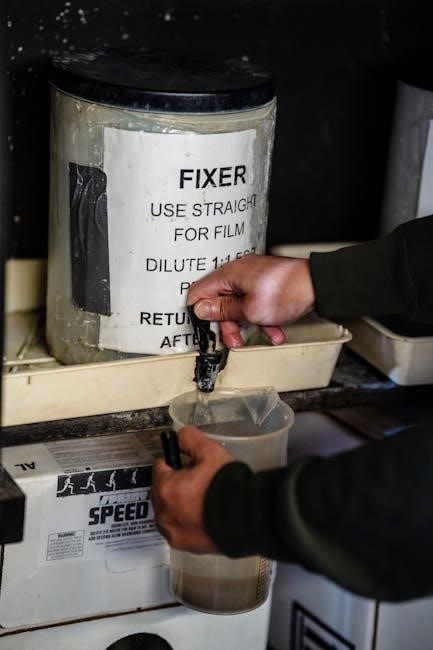
manual label applicator
Manual label applicators are essential tools for precise, efficient labeling in various industries, offering cost-effectiveness, portability, and versatility for small to medium-scale operations, enhancing productivity in labeling tasks.
Overview of Manual Label Applicators
Manual label applicators are cost-effective, portable tools designed for precise label placement on various surfaces. They are ideal for small-scale operations, offering versatility in labeling different materials and shapes. These applicators are easy to use, requiring minimal setup, and are suitable for industries like packaging, retail, and healthcare. Their compact design and affordability make them a practical choice for businesses needing efficient, manual labeling solutions without the complexity of automated systems.
Importance of Manual Label Applicators in Labeling Processes
Manual label applicators play a crucial role in labeling processes by ensuring precision, consistency, and efficiency. They are essential for small to medium-sized businesses, offering affordability and ease of use. These tools enable quick labeling of products, reducing downtime and enhancing productivity. Their portability and versatility make them ideal for various industries, including packaging, retail, and healthcare, where accurate and professional labeling is imperative for product identification and branding.
Advantages of Using Manual Label Applicators
Manual label applicators offer efficiency, cost-effectiveness, and portability, making them ideal for small-scale operations. They provide precise control, versatility, and consistency in labeling various products and surfaces.
Cost-Effectiveness
Manual label applicators are a budget-friendly option for labeling needs, offering significant savings compared to automated systems. They require minimal upfront investment and operate without high energy costs, making them ideal for small businesses or startups. Their durability ensures long-term value, reducing the need for frequent replacements. Additionally, manual applicators eliminate the expense of complex machinery, providing a practical solution for businesses with limited resources while still delivering professional-grade results.
Portability and Ease of Use
Manual label applicators are lightweight and compact, making them highly portable for on-the-go use. Their simple design requires minimal training, allowing users to apply labels quickly and efficiently. This ease of use is ideal for small businesses, startups, or individuals needing to label products without complexity. The portability of these tools ensures they can be used in various settings, from offices to workshops, providing flexibility and convenience for diverse labeling needs.
Precision and Control in Label Placement
Manual label applicators provide exceptional precision and control, enabling users to place labels accurately and evenly. This is particularly important for small-scale operations or unique labeling needs. The ability to adjust label placement by hand ensures professional results, avoiding air bubbles and misalignment; This level of control is ideal for products with curved or irregular surfaces, making manual applicators a reliable choice for achieving consistent and high-quality label placement in various industries.
Versatility in Labeling Different Surfaces
Manual label applicators excel in labeling various surfaces, including cylindrical bottles, jars, cans, and irregularly shaped products. They handle transparent and opaque labels with ease, ensuring a professional finish. Whether applied to glass, plastic, or metal, manual applicators adapt to diverse materials, making them ideal for industries like food, beverage, and retail. Their ability to accommodate different label sizes and types enhances their versatility, allowing users to label curved or flat surfaces with minimal downtime and maximum efficiency.

Types of Manual Label Applicators
Manual label applicators come in various forms, including handheld, benchtop, and semi-automatic models, each designed for specific tasks and offering unique advantages in labeling efficiency and precision.
Handheld Manual Label Applicators
Handheld manual label applicators are portable, lightweight tools ideal for small-scale labeling tasks. They are easy to use, allowing precise placement of labels on various surfaces. These applicators are perfect for low-volume operations, offering flexibility and convenience. They are often used in retail, offices, and small businesses for labeling packages, files, and products. Their compact design and ease of operation make them a popular choice for quick, on-the-go labeling needs, ensuring efficiency without the need for complex setups or extensive training;
Benchtop Manual Label Applicators
Benchtop manual label applicators are sturdy, compact devices designed for consistent, high-quality labeling. They are ideal for small to medium-scale operations, offering enhanced efficiency and accuracy. These applicators are often used in offices, warehouses, and small businesses for labeling packages, files, and products. Models like the Primera LX500 and Brady BMP21-Plus are popular for their durability and ease of use. They typically feature adjustable settings, memory storage for frequent labels, and compatibility with various label sizes, making them versatile tools for everyday labeling needs in professional environments.
Semi-Automatic Manual Label Applicators
Semi-automatic manual label applicators combine manual operation with automated features for efficient labeling. These devices are ideal for cylindrical or irregularly shaped products, offering precise label placement with minimal effort. They are often used in industries like cosmetics, food, and pharmaceuticals, where consistent labeling is critical. Models such as the Primera LX500 and Brady BMP21-Plus are popular for their ease of use, durability, and ability to handle various label sizes and materials, making them a cost-effective solution for medium-scale operations.

How Manual Label Applicators Work
Manual label applicators function through simple, user-driven mechanisms to apply labels onto surfaces, ensuring efficiency and accuracy in labeling processes for various industries and applications.
Basic Mechanism of Manual Label Applicators
Manual label applicators operate through a straightforward process where labels are fed into the device, aligned, and then applied to a surface using a pressure mechanism. Users typically load the labels, position the applicator, and trigger the application, ensuring precise placement. These tools often feature adjustable settings to accommodate different label sizes and materials, making them versatile for various labeling needs while maintaining consistency and ease of use across applications.
Label Application Techniques
Manual label applicators employ techniques such as roll-to-roll feeding for continuous labels or sheet-fed systems for individual labels. They utilize pressure-sensitive mechanisms to ensure labels adhere smoothly to surfaces. Some models offer wrap-around or tamp-application methods for precise placement on curved or flat surfaces, ensuring minimal wrinkles and accurate positioning. These techniques enhance efficiency and consistency, making manual applicators ideal for various labeling tasks in packaging, retail, and industrial settings.
Label Placement Accuracy and Consistency
Manual label applicators are designed to ensure precise and consistent label placement, reducing misalignment and waste. Adjustable guides and spring-loaded mechanisms help maintain accuracy, while ergonomic designs enable smooth application on various surfaces. These tools are particularly effective for small-scale operations, offering reliable control to achieve professional-grade labeling results consistently.
Supported Label Materials and Sizes
Manual label applicators support a variety of label materials, including paper, vinyl, and polyester, ensuring compatibility with diverse labeling needs. They accommodate different label sizes, ranging from small tags to larger formats, and can handle both transparent and opaque labels. Adjustable mechanisms allow precise alignment for labels of varying dimensions, minimizing waste and ensuring proper adhesion on various surfaces, making them versatile tools for consistent and efficient labeling across different applications and industries.

Factors to Consider When Choosing a Manual Label Applicator
Key considerations include label size, shape, material compatibility, durability, build quality, brand reputation, and customer reviews to ensure the applicator meets specific labeling needs effectively.
Label Size and Shape Compatibility
Manual label applicators must accommodate various label sizes and shapes, from small tags to larger formats, ensuring proper adhesion on diverse surfaces like bottles, boxes, or irregularly shaped items. They should handle labels of different materials, including paper, vinyl, and transparent options, while maintaining accuracy and preventing wrinkles. Compatibility with cylindrical objects, such as jars or cans, is crucial for consistent labeling. Selecting an applicator that supports your specific label dimensions and types ensures efficient and professional results across various products and packaging needs.
Application Speed and Efficiency
Manual label applicators offer varying speeds, from basic models applying a few labels per minute to advanced ones handling up to 70 labels per minute. They balance manual operation with efficient labeling, ensuring quick turnaround for small-scale operations. While not as fast as automatic machines, they provide consistent results for low-to-medium volume needs, making them ideal for businesses requiring precise control and reliable performance without high-speed requirements. Their efficiency lies in their ability to maintain accuracy while streamlining manual labeling processes.
Compatibility with Different Label Materials
Manual label applicators are designed to work with a variety of label materials, including paper, vinyl, and polyester. They support different adhesive types, ensuring compatibility with various surfaces and environmental conditions. Models like the Dymo LabelWriter 450 Turbo and Brother QL-1110NWB handle multiple label sizes and materials seamlessly. This versatility allows businesses to use the same applicator for diverse labeling needs, from standard paper labels to durable, weather-resistant options, enhancing flexibility and reducing the need for multiple devices.
Durability and Build Quality
Durability and build quality are crucial for manual label applicators, ensuring long-term performance. High-quality models, such as the Brady BMP21-Plus and Primera LX500, feature robust constructions with metal or high-grade plastic components. These designs withstand frequent use and minimize wear and tear. A well-built applicator reduces the need for repairs or replacements, making it a cost-effective investment for businesses. Durable materials and sturdy engineering ensure consistent labeling accuracy and reliability over time, even in demanding environments.
Brand Reputation and Customer Reviews
Brand reputation and customer reviews are vital when selecting a manual label applicator. Reputable brands like DYMO, Brother, and Zebra are known for producing high-quality, durable devices. Customer reviews often highlight models such as the DYMO LabelWriter 450 Turbo and Brother QL-1110NWB, praised for their efficiency and consistency. Positive feedback from users indicates reliability and satisfaction, helping buyers make informed decisions. A well-regarded brand with strong customer reviews ensures a dependable and long-lasting labeling solution tailored to specific needs and applications.
Top Manual Label Applicators Available in the Market
Leading manual label applicators include the DYMO LabelWriter 450 Turbo, Brother QL-1110NWB, and Zebra ZD620, known for their efficiency, precision, and durability in labeling tasks.
Dymo LabelWriter 450 Turbo
DYMO LabelWriter 450 Turbo
The DYMO LabelWriter 450 Turbo is a high-speed, compact label printer ideal for office and home use. It prints up to 71 labels per minute with exceptional clarity. Compatible with various label sizes, it supports direct thermal printing without ink or toner. Its USB connectivity ensures easy setup with Windows and Mac systems. The included DYMO Label software offers customization options for labels, making it versatile for shipping, filing, and organizing tasks.
Brother QL-1110NWB
The Brother QL-1110NWB is a high-speed label printer designed for efficiency and versatility. It supports wireless printing via Wi-Fi and Bluetooth, making it ideal for mobile use. Capable of printing labels up to 4 inches wide, it delivers crisp 300 dpi resolution for professional results. Compatible with various label materials, it includes Brother’s P-Touch Editor software for custom designs. Its compact design and robust performance make it suitable for offices, retail, and industrial settings, ensuring reliable and high-quality labeling solutions.
Zebra ZD620
The Zebra ZD620 is a top-tier industrial label printer known for its high-speed printing and exceptional print quality. It supports both direct thermal and thermal transfer printing, making it versatile for various label materials. With a print speed of up to 8 inches per second and 203 dpi resolution, it delivers sharp text and graphics. Its intuitive color display and USB hosting capabilities simplify operation and updates. Ideal for retail, healthcare, and manufacturing, the Zebra ZD620 is a reliable choice for demanding labeling environments, offering durability and consistent performance.
Primera LX500
The Primera LX500 is a high-speed desktop label printer renowned for its vibrant print quality and versatility. It supports a wide range of label materials, including paper, polyester, and vinyl, making it ideal for both indoor and outdoor use. With a print speed of up to 4.5 inches per second and 1200 dpi resolution, it delivers crisp text and graphics. Its color LCD display and intuitive interface simplify label creation, while its compact design suits small businesses, offices, and home use. A reliable choice for professional labeling needs.
Brady BMP21-Plus
The Brady BMP21-Plus is a portable and user-friendly manual label applicator designed for industrial and commercial use. It supports a wide range of label materials, including vinyl, polyester, and paper, making it versatile for various applications. Ideal for labeling cables, pipes, and equipment, it ensures crisp text and durable labels. Its compact design and intuitive interface simplify the labeling process, while its ability to handle different label sizes and shapes makes it a reliable choice for professional environments.
Manual vs. Automatic Label Applicators
Manual label applicators are cost-effective, portable tools ideal for small-scale operations, while automatic applicators offer higher speed and scalability for large-volume labeling needs in industrial settings.
Key Differences Between Manual and Automatic Applicators
The primary differences lie in operational method, cost, and scalability. Manual applicators are cost-effective, portable, and ideal for small-scale labeling, requiring minimal investment. Automatic applicators, while more expensive initially, offer advanced features, higher speed, and scalability for large-volume production, making them suitable for industrial environments. Manual applicators rely on human operation, providing precise control for unique or small batches, whereas automatic systems automate the process, reducing manual labor and increasing efficiency for consistent, high-output labeling needs.
Cost Comparison
Manual label applicators are generally more affordable, with prices starting from a few hundred dollars, making them ideal for small businesses or individuals. Automatic applicators, while offering advanced features and higher efficiency, are significantly more expensive, often ranging from a few thousand dollars upward. Manual applicators require minimal upfront investment and are cost-effective for small-scale operations, whereas automatic systems, though pricey, reduce labor costs and increase productivity in the long run, making them a valuable investment for large-scale applications.
Performance and Speed
Manual label applicators are designed for efficient and precise labeling, capable of applying up to 1,200 labels per hour. They excel in handling cylindrical objects like bottles and cans, ensuring wrinkle-free application. While they may not match the speed of automatic systems, manual applicators are ideal for small to medium-scale operations, offering consistent performance and reliability. Their simplicity ensures minimal downtime, making them a practical choice for businesses requiring accurate and efficient labeling solutions without the need for high-volume automation.
Use Cases for Manual vs. Automatic Applicators
Manual label applicators are ideal for small-scale operations, offering precise control for labeling small batches or unique products. They are portable and suitable for businesses with varying label sizes and shapes. Automatic applicators, however, excel in high-volume production, delivering faster labeling speeds and consistency for large-scale industries. Manual applicators are often used in packaging, retail, and healthcare for their flexibility, while automatic systems are preferred in manufacturing and e-commerce for their efficiency and scalability.

Maintenance and Troubleshooting Tips
Regular cleaning and lubrication of manual label applicators ensure smooth operation. Address jams promptly, check label alignment, and replace worn parts to maintain performance and longevity.
Regular Maintenance for Manual Label Applicators
Regular maintenance ensures optimal performance of manual label applicators. Clean the applicator head and rollers frequently to prevent dust buildup. Lubricate moving parts to reduce friction and wear. Check and replace worn-out components like labels rolls or adhesive strips. Store the applicator in a dry, cool place to avoid damage. Following the manufacturer’s maintenance schedule helps extend the lifespan and maintains precise label application.
Common Issues and Solutions
Common issues with manual label applicators include label misalignment, jamming, and worn-out parts. To fix misalignment, adjust the applicator head and ensure labels are loaded correctly. For jams, gently remove stuck labels and clean the mechanism. Replace worn parts like rollers or springs to maintain performance. Regular cleaning and proper storage can prevent these issues. Addressing problems promptly ensures smooth operation and extends the applicator’s lifespan.
Extending the Lifespan of the Applicator
To extend the lifespan of a manual label applicator, regular cleaning and lubrication of moving parts are essential. Store the device in a dry, cool place to prevent rust or damage. Handle the applicator with care to avoid physical stress. Use compatible labels and follow manufacturer guidelines to reduce wear. Replace worn-out parts promptly and avoid overloading the machine. Proper maintenance ensures consistent performance and prolongs the applicator’s durability, making it a reliable tool for long-term use.
Industry-Specific Applications of Manual Label Applicators
Manual label applicators are widely used in packaging, retail, healthcare, and food industries for precise labeling, ensuring compliance and enhancing product presentation across various sectors efficiently.
Use in Packaging and Shipping
Manual label applicators play a crucial role in packaging and shipping by ensuring accurate and efficient label placement on boxes, bottles, and cans. They handle various label sizes and materials, including transparent and opaque options, making them ideal for cylindrical and rectangular containers. These tools are especially beneficial for small businesses and startups, offering a cost-effective solution to maintain professional packaging without requiring extensive machinery. Their portability and ease of use make them indispensable in fast-paced shipping environments, ensuring consistent and high-quality labeling that enhances product presentation and brand identity. Additionally, manual applicators support quick adjustments, allowing for customization in labeling different product lines efficiently. Their reliability in applying wrinkle-free labels ensures products look professional, which is essential for customer satisfaction and brand reputation. Overall, manual label applicators are versatile, durable, and essential for streamlining packaging and shipping processes in various industries.
Applications in Retail and E-Commerce
Manual label applicators are widely used in retail and e-commerce for labeling products, pricing, and inventory management. They are ideal for small businesses and startups, offering a cost-effective solution for labeling items like clothing, cosmetics, and electronics. Their portability and ease of use make them perfect for in-store labeling or preparing online orders. Manual applicators ensure precise and professional label placement, which is crucial for maintaining brand image and customer satisfaction. They are also versatile, supporting various label sizes and materials, making them essential tools for enhancing operational efficiency in retail and e-commerce environments.
Use in Healthcare and Pharmaceuticals
Manual label applicators are crucial in healthcare and pharmaceutical industries for precise and consistent labeling of medications, samples, and medical devices. Their ability to handle small, intricate labels ensures compliance with regulatory requirements. Easy to use and clean, these applicators are ideal for sterile environments, reducing contamination risks. Durability and reliability are key, as they must withstand frequent use in high-stakes settings. Manual applicators meet the high standards of patient safety and operational efficiency, making them indispensable tools in healthcare facilities and pharmacies.
Applications in Food and Beverage Industry
Manual label applicators are widely used in the food and beverage industry for labeling bottles, jars, cans, and packages. They are efficient for small-scale productions, ensuring precise application of labels on various surfaces. These applicators handle transparent and opaque labels, ideal for showcasing product information and branding. Their ease of use and durability make them suitable for consistent labeling in busy kitchens, bakeries, and packaging facilities, maintaining a professional appearance for food and beverage products.
Future Trends in Manual Label Applicator Technology
Future trends include integrating smart technology, developing eco-friendly solutions, and enhancing labeling speed and precision to meet evolving industry demands and sustainability goals effectively.
Integration of Smart Technology
Smart technology integration is revolutionizing manual label applicators by enabling wireless connectivity and mobile app control, allowing real-time monitoring and label customization. Sensors detect label stock levels and adjust alignment automatically, reducing errors. Advanced software provides data analytics for tracking labeling efficiency and maintenance needs. This seamless blend of manual operation with intelligent automation enhances productivity and adapts to modern industrial demands for precision and connectivity, ensuring a future-proof solution for labeling tasks.
Development of Eco-Friendly Labeling Solutions
The development of eco-friendly labeling solutions focuses on reducing environmental impact by using biodegradable or recyclable materials. Manual label applicators now incorporate sustainable practices, such as energy-efficient mechanisms and minimal waste generation. Eco-conscious designs prioritize recyclable components and low-carbon manufacturing processes. This shift supports industries aiming to reduce their ecological footprint while maintaining high labeling standards. By adopting green technologies, manual label applicators align with global sustainability goals, offering environmentally responsible solutions for businesses of all sizes.
Improvements in Labeling Speed and Precision
Recent advancements in manual label applicators have focused on enhancing speed and precision, enabling faster and more accurate label placement. Innovations like adjustable pressure settings and advanced alignment guides ensure consistent results. High-end models, such as the Dymo LabelWriter 450 Turbo, offer rapid labeling capabilities, applying up to 1,200 labels per hour. These improvements make manual applicators more efficient, catering to businesses needing reliable, high-speed labeling solutions without transitioning to fully automated systems, thus bridging the gap between manual and automated labeling processes.
Manual label applicators are versatile, cost-effective tools that streamline labeling processes, offering precision and efficiency for various industries, making them indispensable for businesses seeking reliable labeling solutions.
Final Thoughts on Manual Label Applicators
Manual label applicators remain indispensable tools for businesses requiring precise, efficient labeling solutions. Their affordability, ease of use, and versatility make them ideal for small businesses, startups, and industries needing flexibility. Top models like the Brady BMP21-Plus and Dymo LabelWriter 450 Turbo exemplify innovation and reliability. Regular maintenance, such as cleaning and checking for jams, ensures longevity. Whether for packaging, retail, or healthcare, manual label applicators continue to be essential for streamlining labeling processes and enhancing productivity in diverse settings.
Recommendations for Choosing the Right Applicator
When selecting a manual label applicator, consider your specific labeling needs, such as label size, material, and application surface. Assess compatibility with your workflow and budget. Top-rated models like the Brady BMP21-Plus and Dymo LabelWriter 450 Turbo are highly recommended for their reliability and performance. Prioritize features like label size flexibility, durability, and ease of use. Always read customer reviews and compare brands to ensure you find the best fit for your business requirements.